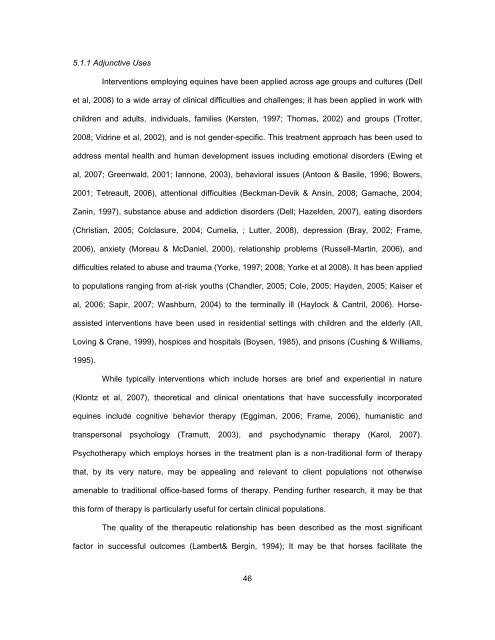A SYSTEMATIC REVIEW OF THE EFFECTS OF PSYCHOTHERAPY ...
A SYSTEMATIC REVIEW OF THE EFFECTS OF PSYCHOTHERAPY ...
A SYSTEMATIC REVIEW OF THE EFFECTS OF PSYCHOTHERAPY ...
You also want an ePaper? Increase the reach of your titles
YUMPU automatically turns print PDFs into web optimized ePapers that Google loves.
5.1.1 Adjunctive Uses<br />
Interventions employing equines have been applied across age groups and cultures (Dell<br />
et al, 2008) to a wide array of clinical difficulties and challenges; it has been applied in work with<br />
children and adults, individuals, families (Kersten, 1997; Thomas, 2002) and groups (Trotter,<br />
2008; Vidrine et al, 2002), and is not gender-specific. This treatment approach has been used to<br />
address mental health and human development issues including emotional disorders (Ewing et<br />
al, 2007; Greenwald, 2001; Iannone, 2003), behavioral issues (Antoon & Basile, 1996; Bowers,<br />
2001; Tetreault, 2006), attentional difficulties (Beckman-Devik & Ansin, 2008; Gamache, 2004;<br />
Zanin, 1997), substance abuse and addiction disorders (Dell; Hazelden, 2007), eating disorders<br />
(Christian, 2005; Colclasure, 2004; Cumelia, ; Lutter, 2008), depression (Bray, 2002; Frame,<br />
2006), anxiety (Moreau & McDaniel, 2000), relationship problems (Russell-Martin, 2006), and<br />
difficulties related to abuse and trauma (Yorke, 1997; 2008; Yorke et al 2008). It has been applied<br />
to populations ranging from at-risk youths (Chandler, 2005; Cole, 2005; Hayden, 2005; Kaiser et<br />
al, 2006; Sapir, 2007; Washburn, 2004) to the terminally ill (Haylock & Cantril, 2006). Horseassisted<br />
interventions have been used in residential settings with children and the elderly (All,<br />
Loving & Crane, 1999), hospices and hospitals (Boysen, 1985), and prisons (Cushing & Williams,<br />
1995).<br />
While typically interventions which include horses are brief and experiential in nature<br />
(Klontz et al, 2007), theoretical and clinical orientations that have successfully incorporated<br />
equines include cognitive behavior therapy (Eggiman, 2006; Frame, 2006), humanistic and<br />
transpersonal psychology (Tramutt, 2003), and psychodynamic therapy (Karol, 2007).<br />
Psychotherapy which employs horses in the treatment plan is a non-traditional form of therapy<br />
that, by its very nature, may be appealing and relevant to client populations not otherwise<br />
amenable to traditional office-based forms of therapy. Pending further research, it may be that<br />
this form of therapy is particularly useful for certain clinical populations.<br />
The quality of the therapeutic relationship has been described as the most significant<br />
factor in successful outcomes (Lambert& Bergin, 1994); It may be that horses facilitate the<br />
46
















